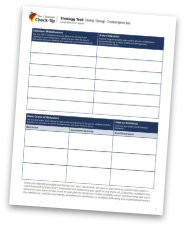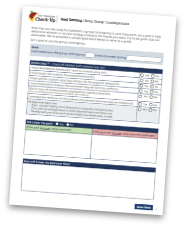Strategy: Using Group Contingencies
Check-Up Menu > Using Group Contingencies
1) Determine problem behaviors using baseline data.
How To
How to Plan and Implement a Group Contingency
- First, gather baseline information about the number and types of misbehaviors that occur regularly in your classroom. You will use these data to determine which behaviors you want to work on and to set goals.
- Second, decide which behaviors you wish to reinforce and the method you’ll use to do so. You can choose to “catch” students exhibiting the chosen behavior and then reinforce it, or you can reinforce for the absence of chosen misbehaviors.
- Third, determine reinforcers that will be effective for your class. See the “Identifying Reinforcers for the Classroom” strategy for more information. You should stick to the categories of “edibles, tangibles, and activities” for whole-class reinforcers.
- Fourth, teach the students the behavioral expectations and the “rules” of the contingency.
- Finally, implement the contingency, making sure to provide plenty of feedback to students.
Example Video:
Video Prompts:
- Notice how the teacher introduces the game to the class and breaks them into groups.
- The Good Behavior Game helps teach student self-regulation by having them inhibit or not display misbehavior. If misbehavior occurs, the team earns a point.
- Notice how the teacher explains the rule for that day.
- The teacher also lets the student know how long the game will occur and what the reward will be for the team with the fewest points.
- Notice that the teacher allows the students to ask questions before the game begins.
- Notice that the teacher provides the reward immediately at the end of the game.
- What did you like about how this teacher used the Good Behavior Game?
- How might you use the Good Behavior Game in your classroom?
Strategy Tool

Reflection

Goal Setting

Use the following form to set your group contingency goals.
References to Other Relevant Resources:
Bowman-Perrott, L., Burke, M. D., Zaini, S., Zhang, N., & Vannest, K. (2016). Promoting positive behavior using the Good Behavior Game: A meta-analysis of single-case research. Journal of Positive Behavior Interventions, 18(3), 180-190.
Ebry, D. (2002). The Good Behavior Game: A best practice candidate as a universal behavioral vaccine. Clinical Child and Family Psychology Review, 5, 273-297.
Maggin, D. M., Johnson, A. H., Chafouleas, S. M., Ruberto, L. M., & Berggren, M. (2012). A systematic evidence review of school-based group contingency interventions for students with challenging behavior. Journal of School Psychology, 50(5), 625-654.
Reinke, W. M., Herman, K. C., & Sprick, R. (2011). Motivational interviewing for effective classroom management: The classroom check-up. New York, NY: Guilford Press.


